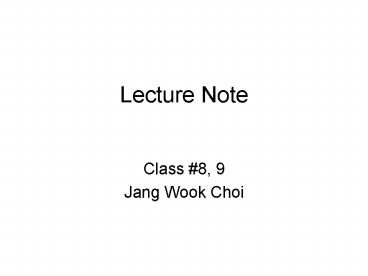Lecture Note - PowerPoint PPT Presentation
Title:
Lecture Note
Description:
Lecture Note Class #8, 9 Jang Wook Choi – PowerPoint PPT presentation
Number of Views:24
Avg rating:3.0/5.0
Title: Lecture Note
1
Lecture Note
- Class 8, 9
- Jang Wook Choi
2
Fermi Energy Pinning
FB
FB
EF,M1
EF,M2
S.C.
Metal 1
S.C.
Metal 2
Expect that ?B depends on EF, M
3
But, This is not the case for some
semiconductors.
Observed a Barner height that is independent of
the contacting metal. For example, FB 0.8
0.9 V for Si.
4
Why does this happen?
vacuum
vacuum
FB
FB
EF,M1
EF,M2
Interfacial layer
S.C.
Metal 1
S.C.
Metal 2
?B,1 ?B,2 but, EF, M1 ? EF, M2 ?Band Edge
Unpinning
5
Exercise) Very clean Si / Magic Metal / Metal
vacuum
You see the Fermi energy pinning because Si /
magic Metal interface always determines Si band
bending. ? Si never sees outer metal layer.
FB
EF,M
Some magic metal
S.C.
Metal
For real Si/Metal contact, Si dangling bonds,
surface states, metal silicides and so on can be
the interfacial layer.
6
FB values for S.C/Metal
Fb,n Fb,p
Si 0.70.8 0.30.4
GaAs 0.9 0.5
InP 0.5 0.85
Fb,n
Fb,p
S.C.
Metal
(Unit V)
Fb,n Barrier for e- Fb,p Barrier for h
7
Equilibrium Before applying bias
ns
FB
nb
EF,M
n(x) nb exp-qV(x) / kT
_at_Surface, ns nb exp-qVbi / kT
S.C.
Metal
nb
n(x)
ps
np ni2 still holds.
pb
ns
p(x)
0
W
8
(No Transcript)
9
(No Transcript)
10
(No Transcript)
11
J0 for Solution Contact
ket
ket
Same as for metal, but now A matters, flux
nsAket ketA- _at_Eq. ns0Aket
ketA- flux ketA(ns ns0)
ns
FB
nb
EF,M
S.C.
Soln
ket depends on -reorganization energy of
A/A- -probability that e- will cross interface
when at the right energy
Current qflux qketAnso(ns/ns0 1)
J0,solnexp(-qVbi/kt) 1 J0(soln) ltlt J0(metal)
since ket ltlt kn
12
Shine Light
h? ? e- h
Low-level injection condition hv ? 1010 1011
carriers cm-3 ?n ltlt n, ?p gtgt p Light doesnt
affect majority carrier. So you have same
electron current, however, now you have much more
holes.
Holes under electric field are attracted to the
interface and transferred.
ns
FB
nb
EF,M
Good assumption all ?p are transferred under the
field. This assumption can be true whatever Vappl
is applied. ? can add a constant value to the
observed current ? Superposition (J
-J0exp(-qVbi/kT) 1 Jph)
?p
S.C.
13
Quantum Yield
External Quantum Yield
Rreflectivity, a absorption factor
Internal Quantum Yield
I.Q.Y. doesnt account for the loss by absorption
efficiency. For Solar cell devices, E.Q.Y. is
what is going to determine the market ability. So
this is what we should be looking at.
14
When Superposition Fails
- ? When not all ?p cross the interface
- at high V, which unbends the bands.
- Low band bending cases low Fb
- Low ket in the interface S.C./M never shows the
failure of superposition. -
S.C/Soln sometimes can.
Open Circuit Voltage
0 - J0exp(-qVoc/kT) 1 Jph ? Jph
J0exp(-qVoc/kT) 1 For Voc gtgt 3kT/q, 1 can be
ignored. Voc
? J0 must be minimized for better solar cell
devices































